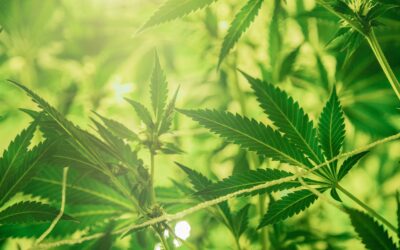Hemp, a versatile and sustainable crop, has been an essential part of human history for centuries. From its use in textiles and paper to its potential as a renewable energy source, hemp offers a multitude of current uses and future possibilities. As we stand at the dawn of a new era focused on sustainable practices and environmental stewardship, the future of the hemp industry holds tremendous promise. The evolving legal landscape, coupled with shifting consumer preferences and technological advancements, is paving the way for a thriving hemp industry. Exploring the trends and predictions for this dynamic sector is crucial to understanding its potential impact on various industries and our collective efforts toward a greener future.
The potential benefits and opportunities hemp offers are plentiful and only recently being recognized. . The legalization and regulatory changes surrounding hemp cultivation and production have set the stage for transformative growth. The passage of the 2018 Farm Bill in the United States and similar developments globally have laid the groundwork for expanded cultivation, research, and commercialization opportunities. Understanding the evolving legal framework and regulatory landscape is key to unlocking the full potential of hemp. Moreover, the increasing demand for sustainable and eco-friendly alternatives across industries presents a unique opportunity for hemp. Its low environmental impact, ability to sequester carbon, and minimal need for pesticides and herbicides make it a compelling choice for farmers, manufacturers, and consumers alike. By exploring the emerging trends and predictions for the hemp industry, we can gain insights into the possibilities that lie ahead and the potential role hemp can play in shaping a more sustainable future.

Legalization and Regulatory Changes:
The passage of the 2018 Farm Bill in the United States marked a significant turning point for the hemp industry. With this legislation, hemp was removed from the controlled substances list, distinguishing it from its psychoactive counterpart, marijuana. The Farm Bill opened the floodgates for hemp cultivation, processing, and the production of hemp-derived products. Since then, a rapid expansion of hemp farming operations is occurring across the country. This legalization provides farmers with a new opportunity to diversify their crops and tap into the economic potential of hemp. Furthermore, legalization facilitates research and development initiatives focused on unlocking the full potential of this versatile plant. As the legal barriers continue to be dismantled, the expectation is an even more robust and thriving hemp industry in the years to come.
The United States is not alone in embracing hemp’s economic and environmental potential. Countries around the world are recognizing the value of this versatile crop and enacting their own legalization measures. Canada, for instance, has a well-established hemp industry, and other countries such as Australia, Germany, and Uruguay have also legalized hemp cultivation. This global trend indicates a growing acceptance and understanding of hemp’s benefits. As more countries recognize hemp’s economic and ecological advantages, we can anticipate increased cultivation, trade, and cross-border collaborations in the industry. Additionally, international harmonization of hemp regulations will likely facilitate global commerce, creating new opportunities for market growth and innovation.
Looking ahead, predictions for the future of hemp legalization and regulations are promising. As governments and regulatory bodies become more educated about the distinctions between hemp and marijuana, further relaxation of restrictions is anticipated. This could include the removal of remaining barriers to hemp cultivation, processing, and interstate commerce. The potential establishment of standardized testing protocols and quality control measures will enhance consumer confidence in hemp-derived products. Additionally, regulatory frameworks may evolve to address emerging sectors, such as hemp-based pharmaceuticals and dietary supplements. As the industry matures and gains wider acceptance, regulatory changes will play a vital role in shaping the future of hemp, fostering innovation, and ensuring consumer safety.

Sustainable and Eco-Friendly Practices:
Hemp cultivation offers a range of environmental benefits that position it as a sustainable alternative to traditional crops. Hemp requires minimal pesticide and herbicide use compared to other agricultural commodities, reducing the environmental impact on ecosystems and waterways. Furthermore, hemp is known for its ability to grow in diverse climates and soil conditions, reducing the need for excessive irrigation. This water efficiency, coupled with its fast growth rate, makes hemp an appealing choice for farmers seeking sustainable agricultural practices. By incorporating hemp into crop rotations, farmers can break the cycle of monoculture, improve soil health, and reduce the risk of pests and diseases. These sustainable farming practices not only benefit the environment, but also promote long-term agricultural resilience.
When comparing hemp’s sustainability to other materials, such as cotton or synthetic fibers, hemp emerges as the clear winner. Hemp fibers are stronger and more durable than cotton, requiring fewer resources for production. Additionally, hemp is a highly renewable resource, with a short growth cycle of around four months. As a result, the demand for hemp-based textiles, paper, and packaging materials has steadily increased. By embracing hemp as a viable alternative, industries can reduce their carbon footprint, conserve water, and minimize the use of harmful chemicals. The shift towards hemp-based materials contributes to a more circular and sustainable economy.
An intriguing aspect of hemp’s sustainability lies in its potential to act as a carbon sink. Hemp plants have the remarkable ability to absorb significant amounts of carbon dioxide from the atmosphere during their growth cycle. As a result, hemp cultivation has the potential to play a crucial role in carbon sequestration, an important step in mitigating the effects of climate change. This environmental benefit positions hemp as a valuable tool in sustainable land management strategies, offering a scalable solution for carbon reduction efforts. By incorporating hemp farming into agricultural practices and reforestation initiatives, the carbon sequestration potential of hemp on a large scale can be harnessed.
Predictions for the future of sustainable hemp practices are optimistic. As environmental awareness grows and consumers prioritize eco-friendly products, the demand for sustainable alternatives will continue to rise. This trend will drive innovation in hemp cultivation techniques, including organic and regenerative farming methods. The development of sustainable processing and manufacturing technologies will further enhance the eco-friendly profile of hemp-derived products. Additionally, collaborations between the hemp industry and other sectors, such as construction and textiles, will lead to the development of new materials and applications. These advancements will contribute to a more sustainable future by reducing resource consumption, minimizing waste, and combating climate change through hemp’s unique environmental attributes.

Industrial Applications:
The industrial applications of hemp are diverse and expanding. Currently, hemp is used in industries such as textiles, paper, biofuels, and food. Hemp fibers are known for their strength and durability, making them ideal for textile production. Hemp-based textiles offer a sustainable alternative to conventional fabrics, with applications ranging from clothing to home furnishings. In the paper industry, hemp pulp can be used to manufacture high-quality paper products with a lower environmental impact compared to wood-based paper. Additionally, hemp seeds and oil have gained popularity as a beneficial food supplement and are incorporated into a variety of products, including protein powders, cooking oils, and snacks. As the industry evolves, we can expect further exploration and development of hemp’s applications, leading to new and innovative uses.
Hemp-based composites have gained attention for their advantages in the automotive, aerospace, and construction sectors. Hemp fibers can be combined with resins to create lightweight and strong composite materials. In the automotive industry, these composites can replace conventional materials, reducing the weight of vehicles and improving fuel efficiency without compromising safety. In the aerospace sector, hemp-based composites offer high strength-to-weight ratios, making them valuable for aircraft components. The construction industry can benefit from hemp composites in various ways, such as using them for insulation, panels, and even structural elements. These composites provide excellent thermal and acoustic properties while being environmentally friendly. The use of hemp-based composites in these industries not only offers performance advantages but also contributes to sustainability efforts by reducing carbon emissions and promoting resource efficiency.
Predictions for future advancements and innovations in hemp-based industrial applications are promising. As research and development in the hemp industry continues to grow, advancements in processing techniques that enhance the quality and versatility of hemp-based materials are expected. There will likely be increased focus on improving the mechanical properties of hemp composites to meet specific industry requirements. Furthermore, collaborations between researchers, manufacturers, and end-users will drive innovation and the exploration of new applications. The integration of nanotechnology and hemp fibers holds potential for further enhancing the performance characteristics of hemp-based materials. As industries strive for more sustainable and environmentally friendly alternatives, hemp’s unique properties make it a valuable candidate for various industrial applications. The future will likely see continued investment in research, development, and commercialization of hemp-based industrial solutions, resulting in a broader range of applications and wider adoption across sectors.

Health and Wellness:
Hemp-derived wellness products, particularly those containing CBD (cannabidiol), have gained significant attention in the health and wellness industry. CBD is a non-psychoactive compound found in hemp that interacts with the body’s endocannabinoid system, which plays a crucial role in regulating various physiological functions. CBD wellness products include oils, tinctures, capsules, topicals, and edibles. These products have become increasingly popular due to their potential therapeutic benefits and the growing consumer interest in natural alternatives for health and well-being. The availability and diversity of hemp-derived CBD products have expanded, catering to different needs and preferences.
CBD holds immense potential for various therapeutic benefits, although research in this field is still ongoing. Preliminary studies suggest that CBD may have anti-inflammatory, analgesic, anxiolytic, and neuroprotective properties. It shows promise in managing chronic pain, reducing anxiety and depression symptoms, alleviating sleep disorders, and even supporting epilepsy treatment. Ongoing research aims to further understand CBD’s mechanisms of action, dosage guidelines, and potential applications in treating other conditions. As scientific understanding advances, more evidence-based studies that validate and explore the therapeutic benefits of CBD, expanding its potential uses in healthcare and wellness are likely.
Predictions for the growth of the CBD market are highly optimistic. The demand for CBD products has skyrocketed, driven by increasing consumer awareness and favorable regulatory changes in many countries. As more people seek natural and holistic approaches to health and wellness, the market for CBD is expected to continue its rapid expansion. The potential for CBD to enter new product categories is also significant. The development of CBD-infused beverages, skincare and beauty products, pet supplements, and even pharmaceutical formulations is anticipated. The integration of CBD into various sectors reflects the versatility of this compound and its potential to cater to a broad range of consumer needs. As CBD becomes more mainstream and widely accepted, the market will likely see increased innovation, product diversity, and market penetration.

Hemp in Agriculture and Crop Rotation:
Hemp plays a crucial role in regenerative agriculture and the improvement of soil health. Hemp has deep roots that help break up compacted soil and improve its structure, allowing for better water retention and nutrient absorption. Furthermore, hemp plants have a dense growth habit that can suppress weeds, reducing the need for herbicides. As hemp grows, it also accumulates biomass, which can be incorporated back into the soil as organic matter, enriching its fertility. This makes hemp an excellent cover crop option for farmers practicing regenerative agriculture, as it helps restore soil health, promotes biodiversity, and reduces erosion.
One of the significant benefits of hemp as a rotational crop is its impact on pest control. Hemp naturally repels certain pests, making it a useful tool in integrated pest management strategies. By incorporating hemp into crop rotation, farmers can disrupt pest life cycles and reduce the risk of infestations in subsequent crops. Hemp’s ability to naturally resist pests and diseases minimizes the need for chemical pesticides, promoting environmentally-friendly farming practices. Additionally, hemp’s dense growth can act as a physical barrier against weeds, further reducing the reliance on herbicides. This integration of hemp in crop rotation systems enhances overall pest management, reduces chemical inputs, and supports sustainable agricultural practices.
Predictions indicate increased adoption of hemp in agricultural practices and significant implications for farmers. As the understanding of hemp’s benefits and versatility grows, more farmers are likely to explore hemp cultivation as a viable option. The demand for hemp-based products, such as textiles, construction materials, and wellness products, is on the rise, creating economic incentives for farmers. Furthermore, hemp cultivation can diversify revenue streams and provide additional income opportunities. The integration of hemp in agricultural practices also aligns with consumer preferences for sustainable and environmentally-friendly products, increasing market demand. However, farmers considering hemp cultivation should be mindful of the regulatory landscape and ensure compliance with local regulations and licensing requirements. As the hemp industry continues to mature and gain stability, farmers can expect more robust support, resources, and knowledge-sharing networks to facilitate successful hemp cultivation and maximize its potential benefits.
Market and Economic Predictions:
The hemp industry has experienced remarkable growth in recent years, and current market size projections are impressive. According to market research, the global hemp market was valued at over $5 billion in 2020 and is expected to reach $13.03 billion by 2027, growing at a compound annual growth rate (CAGR) of 16.1%. This growth is driven by various factors, including the increasing demand for hemp-derived products, favorable regulatory changes, and shifting consumer preferences towards sustainable and natural alternatives. The legalization of hemp cultivation in many countries has opened up opportunities for farmers, manufacturers, and entrepreneurs to tap into this emerging market. As the industry continues to evolve and new applications for hemp are discovered, anticipatation of sustained growth and expansion is expected.
Predictions for the expansion of the hemp market span across various sectors. Hemp’s versatility makes it a valuable resource for industries such as textiles, construction, food and beverages, personal care, and pharmaceuticals. In the textile industry, the demand for sustainable and eco-friendly fabrics is driving the use of hemp fibers. Hemp-based textiles are gaining popularity due to their durability, breathability, and low environmental impact. The construction industry is also embracing hemp for its potential as a sustainable building material, offering benefits such as improved insulation and reduced carbon emissions. In the food and beverages sector, hemp seeds and CBD-infused products are gaining traction as consumers seek out healthy and natural options. The pharmaceutical industry is exploring the potential of hemp-derived compounds for various therapeutic applications. With the continuous development of new product categories and applications, the hemp market is poised for substantial expansion across multiple sectors.
The future of the hemp industry presents both economic opportunities and challenges. On the one hand, the growing market demand for hemp-derived products opens up new avenues for revenue generation and job creation. Increased cultivation and processing operations create opportunities for farmers, manufacturers, and retailers, stimulating economic growth in rural and urban areas. Moreover, the sustainable nature of hemp aligns with the growing emphasis on green and clean technologies, positioning the industry to benefit from the global shift towards sustainability. However, challenges persist, including regulatory complexities, quality control standards, and market competition. Regulatory frameworks need to continue evolving to ensure consumer safety, quality assurance, and fair market practices. Additionally, the influx of new entrants into the industry may lead to increased competition, requiring businesses to differentiate themselves through innovation, product quality, and branding. Navigating these challenges and capitalizing on the economic opportunities will be key to the long-term success and sustainability of the hemp industry.
Research and Innovation:
Ongoing research initiatives in hemp cultivation, genetics, and product development are contributing to the expansion and improvement of the industry. Researchers are exploring various aspects of hemp cultivation, including optimal growing conditions, disease and pest resistance, and crop management techniques. Genetic studies aim to identify and develop hemp strains with desirable traits, such as higher CBD content, improved fiber quality, or specific terpene profiles. Additionally, research is focused on optimizing extraction methods to enhance the efficiency and purity of hemp-derived compounds. The exploration of novel product formulations and delivery systems is also ongoing, aiming to improve bioavailability and enhance consumer experiences. These research efforts not only advance our understanding of hemp, but also pave the way for innovation and the development of new applications.
Predictions for future breakthroughs and technological advancements in the hemp industry are exciting. As research in hemp genetics continues, the development of specialized hemp varieties tailored for specific purposes, such as high-CBD strains for therapeutic applications or high-fiber strains for industrial use are anticipated. This will enable farmers to cultivate hemp with enhanced characteristics, increasing the efficiency and value of their crops. Technological advancements in cultivation practices, such as precision farming techniques, automation, and remote sensing, will contribute to higher yields and resource efficiency. In product development, improved extraction methods that maximize the extraction of valuable compounds while minimizing waste are expected. Furthermore, the integration of nanotechnology and hemp-derived materials holds potential for creating innovative products with enhanced properties and applications. The future of research and innovation in the hemp industry is poised to revolutionize cultivation practices, genetic improvements, and product development, opening doors to new possibilities and market opportunities.
Challenges and Considerations:
The hemp industry faces potential obstacles and challenges that need to be addressed for its continued growth and success. One significant challenge is the lack of standardized regulations across different regions and countries. Varying regulations on hemp cultivation, extraction methods, product labeling, and marketing can create confusion and hinder the industry’s progress. Another challenge is the need for improved infrastructure and processing facilities to meet the increasing demand for hemp-derived products. Developing efficient supply chains and infrastructure networks is crucial to ensure the timely processing and distribution of hemp crops. Additionally, access to financial services, including banking and loans, can be challenging for hemp businesses due to the association with cannabis, despite the legal distinctions between the two.
Regulatory hurdles and international trade implications pose complex challenges for the hemp industry. The legal status of hemp and its derivatives can vary significantly from country to country, making international trade and export challenging. Harmonizing regulations and establishing clear guidelines for the cultivation, processing, and sale of hemp-derived products would facilitate trade and encourage market growth. Additionally, issues related to THC (tetrahydrocannabinol) content and testing standards present regulatory challenges. Accurate and consistent testing methods are necessary to determine THC levels and ensure compliance with legal requirements. Overcoming these regulatory hurdles and fostering international collaboration will be essential for the hemp industry to thrive on a global scale.
Social perceptions and stigma surrounding hemp continue to impact the industry. While awareness and acceptance of hemp’s potential benefits have increased, there are still lingering misconceptions and stigma associated with hemp due to its association with cannabis. Some individuals may still perceive hemp as a drug, despite its lack of psychotropic attributes, rather than recognizing its diverse uses and economic potential. Educating the public about the differences between hemp and marijuana, highlighting the sustainable and versatile nature of hemp, and showcasing its numerous applications can help combat these misconceptions. Additionally, engaging in open dialogue, collaborating with stakeholders, and showcasing success stories can contribute to shifting social perceptions and reducing the stigma surrounding hemp.
Navigating these challenges and considerations requires collaborative efforts between industry players, policymakers, and the public. Addressing regulatory inconsistencies, investing in infrastructure, and promoting education and awareness will be crucial for the hemp industry to overcome obstacles, seize opportunities, and pave the way for a thriving and sustainable future.
Let’s wrap it up, here is what we learned:
In this post, we have explored various trends and predictions for the future of the hemp industry. We discussed the impact of legalization and regulatory changes, the importance of sustainable and eco-friendly practices, the industrial applications of hemp, the growth of the CBD market, the role of hemp in agriculture and crop rotation, market and economic predictions, research and innovation, as well as the challenges and considerations facing the industry.
The outlook for the future of the hemp industry is optimistic. With increasing consumer demand for sustainable and natural products, hemp is positioned to play a vital role in various sectors, including textiles, construction, health and wellness, and agriculture. The versatility of hemp and its potential as a renewable resource make it a valuable candidate for innovation and market growth. As technology advances, regulations evolve, and research progresses, we can expect breakthroughs and advancements that will further solidify hemp’s place in the global economy.
As the hemp industry continues to evolve, it is essential for readers to stay informed and engaged. By keeping up with the latest research, regulatory developments, and market trends, individuals can make informed decisions and contribute to the industry’s growth and success. Supporting sustainable and ethical hemp products, advocating for favorable regulations, and fostering dialogue about the benefits of hemp can all play a part in shaping the industry’s future. By staying informed and engaged, we can collectively drive positive change and unlock the full potential of hemp.
In conclusion, the future of the hemp industry is bright, with significant growth potential across various sectors. With its sustainable attributes, diverse applications, and potential health benefits, hemp is poised to make a lasting impact on the global economy and contribute to a more sustainable and environmentally conscious future. By embracing innovation, addressing challenges, and fostering collaboration, we can unlock the full potential of hemp and create a thriving industry that benefits both businesses and consumers alike.





0 Comments